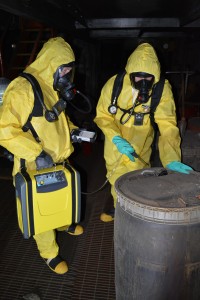North Shore Environmental Construction, Inc. (NSEC) has purchased a Gasmet DX4040 FTIR (Fourier Transformed Infrared) gas analyzer. NSEC has now extensively trained its staff on the use of the real-time FTIR and has implemented its use to measure real-time measurement of gasses. This state-of-the-art technology allows NSEC to “take the lab to the jobsite” and to quantify the known gasses and identify the unknown gasses present. This whitepaper highlights the strengths, limitations and modern technology associated with FTIR real-time gas detection, to provide a better understanding of how this instrument can be used for various real-time gas detection scenarios. It also highlights the state-of-the-art in FTIR technology and why this technology is suitable for emergency response scenarios, and some well-respected governmental agencies use this technology.
Background, Strengths and Limitations
The Gasmet DX4040 portable FTIR (Fourier Transformed Infrared) gas analyzer is a highly technical, portable instrument that is capable of performing multi-component gas analysis from ambient air. This portable instrument contains an FTIR spectrometer that detects specific vibrations, rotations and combinations of molecules within a compound by measuring the compounds’ specific absorbance of infrared radiation. Due to the fact that the infrared absorption spectrum is unique to each specific gas molecule and compound, the analyzer can identify and quantify compounds present in the ambient air. Further, it can accurately and simultaneously identify and quantify up to 25 compounds in a matter of seconds. The portable nature of the analyzer allows a technician to easily transport it around a facility or area and measure the concentrations and identify unknown compounds. This makes the FTIR an invaluable instrument for first responders, occupational and environmental safety personnel, and countless other applications.
The FTIR communicates with a handheld PDA that can provide the real-time airborne concentrations of 25 compounds. The FTIR is accompanied with the Calcmet Software which can be used to retrospectively analyze the measured spectra using the Calcmet Software reference library of thousands of compounds. The reference spectrum contains the known spectrum of identified gases with unknown gasses can be compared to identify the specific compound(s) and concentration present. Specific gas libraries include hydrocarbons, organic compounds, and inorganic compounds.
A few strengths of the instrument include that preparation for the sampling is not required, it provides real-time results, and it is portable with battery operation with wireless communication to the PDA. The shortest sampling time for gasses is five seconds and typical response time is less than 120 seconds, the quickness and availability of real-time results allows the field technicians to perform expeditious decision making to protect workers, as well as save time and money. Additionally, the analyzer has stable calibrations which means that no regular consumables are required to maintain the device (no span calibrations required) and no recalibration is required. Further, low concentrations of organic and inorganic compounds can be detected and, as previously mentioned, 25 gases can simultaneously be monitored with more analyzed post-measurements using the Gasmet software spectra reference library.
There are a few limitations to the FTIR, including it cannot be used in wet, extreme heat or cold environments (short term sampling temperature range is 0 to 40°C and the long term temperature range is 5 to 30°C); therefore, it can only operate at ambient temperatures. Further it should be noted that, all gases absorb infrared light except diatomic homonuclear molecules (O2, N2, H2, Cl2, F2), metals (mercury and lead), the noble gases (He, Ne, Ar), and hydrogen sulfide (H2S) which is a very weak infrared absorber; therefore the FTIR is not the preferred or recommended instrument to identify and quantify these compounds. For real-time analysis the compound(s) needs to be previously selected as the 25 reference compounds; however, up to 50 compounds can be evaluated simultaneously from the spectra and additional compounds can be identified and quantified post-measurement using the Calcmet PC software. The use of the PC software requires additional time but can be performed much more rapidly than sending samples for traditional laboratory analysis.
Accuracy, Precision, Stability and Validation
The FTIR maintains a stable calibration, therefore no span calibration is required. A zero point calibration is performed every 24 hours using nitrogen (99.999% purity or higher N2 recommended) or ambient air. There is a 2% margin of error and a 2% temperature drift when the instrument is measuring the samples at varying temperatures but the instrument compensates for these changes. According to Gasmet, the DX4040 FTIR Methodology is accepted by: NIOSH Method 3800, USEPA Method 320, ASTM Method D6348, TUV (German) & MCERTS (UK) 3rd Party verification, and the US Military Edgewood Report. Further the following is a list of governmental agencies and industries that currently utilized the DX4040:
• United States Military;
• United States Environmental Protection Agency;
• Idaho DEP;
• Oregon OSHA;
• St. Louis, LA County, and Lexington Fire Departments;
• Maricopa Air Board;
• Michigan Region 3 HAZMAT;
• Dow Corning;
• 3M;
• CSX Transport;
• IBM (FD);
• Chevron Phillips; and
• Starbucks.
According to the Gasmet, “The key features of the Gasmet DX4040 include a high sensitivity sample cell for lowest possible detection limits and a built-in-pump, which means that there is no need to use a separate sampling system.”
Uses
Also according to Gasmet, “The DX4040 model analyzer is designed for on-site measurements of various organic and inorganic compounds at low concentrations in ambient air.” The FTIR is capable of detecting and measuring low concentrations (sub-parts per million) of 5000 plus chemical compounds including the following:
• Volatile organic compounds (VOCs) including acetone, hexane and alcohols;
• Natural gas leaks;
• Carbon monoxide;
• Acid gases including hydrochloric acid and hydrofluoric acid;
• Inorganic gases including ammonia, phosphine, nitrogen and sulfur oxides;
• Aromatic gases including benzene, phenol, cumene; and
• Other compounds including vinyl chloride, methylene chloride, ethylene dichloride, Freons, sulfur gases, and amines.
The FTIR is a versatile gas analyzer that can be used for numerous applications and is specially designed for industrial hygiene work and emergency response. The rapid results provided by the FTIR allows technicians to evaluate scenarios in real-time to protect workers and save time and money. Additionally, it is an invaluable tool for industrial hygienists to identify “hot spots” in certain rooms/industrial areas and to evaluate task-specific exposure concentrations. These measurements can allow an industrial hygienist to evaluate peak exposure concentrations that may contribute to workplace exposures and isolate these specific tasks to decrease potential workplace exposures. Further, Gasmet describes the following applications for the DX4040:
• Industrial hygiene – Workplace Air Quality measurement of volatile organic compounds for regulatory compliance testing, identifying toxic industrial chemicals;
• Hospitals – Anesthetic gases, sterilizer gases, laboratory solvents;
• Leak detection – VOC’s, Freons, inorganic gases etc.;
• Fumigants/pesticides – Detection of residual fumigants in cargo sea containers;
• Soil gas measurements – Identification of contaminated land including chlorinated hydrocarbons and BTEX at remediation sites;
• Greenhouse gas soil flux measurements; and
• First responders & HAZMAT teams – Identification and quantification of Toxic Industrial Chemicals (TICs) and Chemical Warfare Agents (CWAs) and fire investigations.
NSEC would be happy to discuss and demonstrate the technology for your organization. NSEC maintains the Gasmet DX4040 and a highly trained field technician on a 24 hour, 7-day per week basis to respond and measure a wide-variety of airborne contaminants. Additionally, NSEC has a 40-hour HAZWOPER-trained, on-call Certified Industrial Hygienist (CIH) and toxicologist to assist in data interpretation, sample planning, human health evaluation and regulatory compliance issues for NSEC’s clients.
For additional information about the Gasmet, please click Here







